This day in history 28 October
Images

Yoker: Platform view at Yoker in October 1957, looking south east towards Glasgow city centre. The station carried the suffix 'High' at that time but reverted to plain Yoker in 1965.
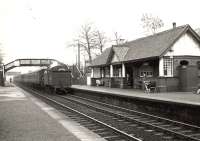
Scotstounhill: Gresley V3 67625 arriving at Scotstounhill on 28 October 1957 with a Helensburgh Central train.

Old Oak Common: King class 4-6-0 no 6028 'King George VI' under cover at 81A Old Oak Common on 28 October 1962.
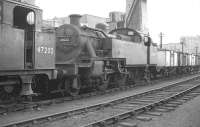
Kentish Town: Fowler ex-LMS 2-6-2T no 40022 on shed at Kentish Town (14B) in October 1962. Nearest the camera is 3F 0-6-0T 47202 (of 1899 vintage). Both locomotives are fitted with condensing apparatus for operating over the Metropolitan widened lines.
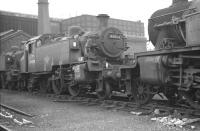
Kentish Town: BR Standard class 2 2-6-2T 84008 in the shed yard at Kentish Town in October 1962.

Kentish Town: Stanier 3P 2-6-2T no 40203 on shed at 14B Kentish Town in 1962, shortly before withdrawal.

Kentish Town: Ex-LMS locomotives stabled in the sidings at Kentish Town shed (14B) in October 1962. Class 3F 0-6-0T 47202 (of 1899 vintage) stands in front of 3P 2-6-2T no 40022. Both locomotives are fitted with condensing apparatus for operating over the Metropolitan widened lines.
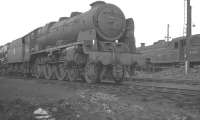
Willesden Shed: Royal Scot no 46159 The Royal Air Force photographed at 1A Willesden on 28 October 1962, some 5 weeks prior to official withdrawal on 1 December.
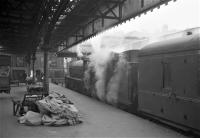
Buchanan Street: B1 61407, after arrival at Buchanan Street, with the 8.48 am from Leven in October 1966.
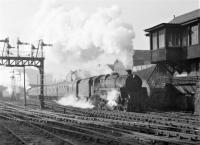
Buchanan Street: Caprotti Standard 5MT 73150 leaves Buchanan St with the 11.35 to Thornton on 28th October 1966. B1 61407 is giving a helpful shove, having previously brought in the stock on the 10.50am arrival from Leven.

Carlisle Kingmoor Shed: Britannia Pacific no 70025 Western Star is just one of a number of steam locomotives stabled inside Kingmoor shed in this photograph thought to have been taken in October 1967.
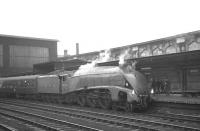
Carlisle: The RCTS Border Limited at Carlisle on 28 October 1967 behind 4498 Sir Nigel Gresley. The special had originated from Nottingham Midland and ran north as far as Longtown via the Carlisle goods lines and Canal Junction, before returning south via Mossband and Kingmoor shed. 4498 had taken over at Kingmoor for the leg south to Skipton. See image [[34628]]

Carlisle Kingmoor Shed: A4 Pacific no 4498 Sir Nigel Gresley stands alongside Carlisle Kingmoor shed on 28 October 1967 with the RCTS (E Midlands, Lancs and North West branches) special 'The Border Limited' on its way back to Nottingham.
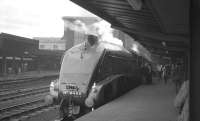
Carlisle: A4 Pacific 4498 Sir Nigel Gresley at Carlisle on 28 October 1967 with the RCTS Border Limited. The A4 had taken over the special at Kingmoor shed on its return journey from Longtown to Nottingham via Mossband and would take the train as far south as Skipton see image [[34628]].
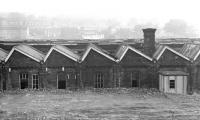
Mirfield: Mirfield shed was a typical LMS rebuild of an ex-L&YR standard shed, with a single roof pitch over each shed road and the original north light pattern roof retained over workshops and stores to one side. Closed in April 1967, the buildings were still substantially intact over six years later. Photographed from Woodend Road on the south side of the Calder Valley main-line.
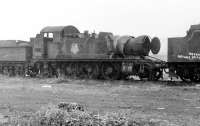
Barry: Looking rather as though the safety valves stuck on its last run, GWR 2-6-2T 5526 stands in one of the scrap lines at Barry in October 1975. As with most of the other occupants its was eventually rescued and has since been transformed into a push-pull fitted tank engine working on the Dart Valley line. See image [[34313]]
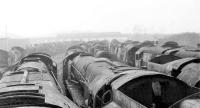
Barry: Row upon row of Bulleid Pacifics, and a few other classes too, stand in Woodhams scrapyard in Barry in October 1975. In the background a Valleys suburban DMU crosses to Barry Island. Later rescued, a number of these locos would subsequently take part in the 2017 50th Anniversary galas commemorating the end of Southern Steam.
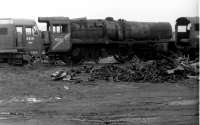
Barry: 45699 Galatea looking very woebegone in Barry scrapyard in 1975. Compared with Bill Jamieson's picture five years earlier the centre driving wheels have been cut through and the chimney has disappeared. The loco left the yard in 1980 to Tyseley, originally as a source of spares, but in 2002 went to West Coast Railways - and the rest is preservation history See image [[47860]]. The NBL Type 2 buffered up to 45699 is widely reported as D6122, but one cab displayed D6121 as seen here leading to disputes about identity.
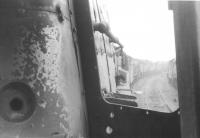
Barry: Fireman's view from the cab of a Barry resident, looking along the rusting lines in October 1975. Although some had left for preservation by this time, and the yard was busy scrapping rail wagons, it was impossible to imagine the great majority of these rusting locos would survive.
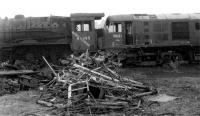
Barry: Two sorry looking specimens in Woodhams scrapyard. Barry on 28th October 1975. On the left, with its centre driving wheels cut through, is 45699 Galatea. Incredibly, this would later return to main line service hauling trains over Shap and the Settle & Carlisle lines. The NBL Type 2 was less fortunate and was eventually cut up in the yard.
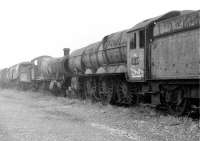
Barry: A very sad looking GWR 6023 King Edward II, in Barry scrapyard in 1975 with its rear driving wheels cut through. Beyond lie an equally decrepit GWR 2-8-0 and a Bulleid Light Pacific. At the time the painted Reserved notices on the King seemed optimistic but the Great Western Society has done a magnificent job of restoration See image [[58065]].
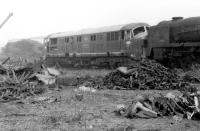
Barry: North British A1A-A1A Warship D601 Ark Royal seen buffered up to a Bulleid Pacific in Barry scrapyard in 1975. It lingered here for a further five years before being cut up in June 1980. See image [[38660]]

Aviemore Shed: No 828 alongside no 60 on Aviemore shed in October 1980.

Inverkeithing: 40033 with a freight at Inverkeithing on 28 October 1982.
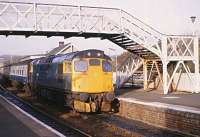
Inverkeithing: 27018 bound for Waverley calls at Inverkeithing at 1426 hours on 29 October 1982. The station building seen here still stands but the footbridge has been replaced by a newer model further north with ramps.
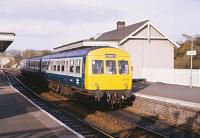
Inverkeithing: An Edinburgh bound 101339 pauses at Inverkeithing at 1420 hours on 28 October 1982. Of over 500 Class 101 vehicles built nearly fifty have survived in preservation.

Inverkeithing: Metropolitan-Cammell Class 101 DMU 101302 heading north to Kirkcaldy passing through Inverkeithing in 1982. The last Met-Cam sets were not finally withdrawn from the main line until 2003.
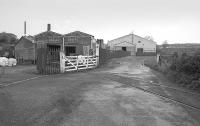
Balbirnie Mills: Looking west over the Sappi Graphics/Balbirnie Mill siding off the Tullis Russell branch which continues to the right. A cargowaggon peeps out from behind a building to the left. Rail services finished soon after this shot was taken in October 1984. The mills have since been demolished to make way for housing but the rails remain in the roadway in 2015. [Ref query 10268]

Prestonhall Level Crossing: Prestonhall level crossing on the Auchmuty (Tullis Russell) branch in October 1984. Note the decrepit hut!

North Queensferry: The first consignment of London Underground stock for refurbishment at Babcock Rosyth arrives in Fife behind 37 083 on 28 October 1991
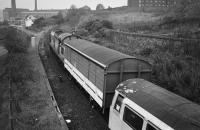
Inverkeithing South Junction: 37083 eases down the Rosyth Dockyard branch on 28 October 1991 with London Underground cars for refurbishment at Babcock Rosyth.

Kingsknowe: GNER Glasgow Central - Kings Cross train on Kingsknowe level crossing, Edinburgh, in October 2002.
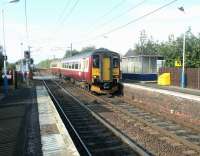
Kingsknowe: A Glasgow Central - Edinburgh Waverley service eases over the level crossing into Kingsknowe station on 28 October 2002.

Cowlairs Tunnel: Since my last visit to this spot the rolling stock has been entirely renewed. The arrival of a train is not preceded by smoke erupting from the tunnel.
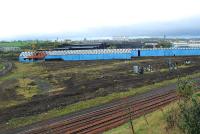
Sighthill West Junction: Looking west from Sighthill West Junction over the former CGU line and Sighthill Goods line to the former Turkey Yard and Cowlairs Carriage Depot. The Cowlairs chord is to the left.

Cowlairs Carriage Sidings: The shed at the Cowlairs Carriage Sidings viewed from the east with the remains of the train-washer in the foreground.

Cowlairs West Junction: E&G train heading for Glasgow. View looks west with the CGU in the foreground.

Cowlairs West Junction: Looking south from Cowlairs Junction. CGU to left, the lifted Cowlairs Carriage Sidings Central and line to Queen Street right.

Ashfield: Eastbound DMU for Queen Street at Ashfield in 2006.

Cowlairs North Junction: Glasgow bound Sprinter crawls slowly past Cowlairs North Junction to a red signal on the approach to Cowlairs West Junction and the main E&G line into Queen Street.
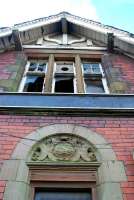
Possil: Frontage of the unloved building at Possil.
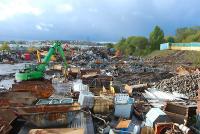
Possil: Oh dear. Scrapyard occupies the site of Possil station. There were two through platforms to the right and a bay to the left. View looks west.
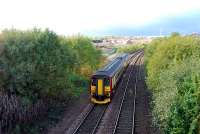
Possilpark: Westbound Sprinter at the site of Possilpark station. The replacement Possilpark and Parkhouse station is behind the camera.
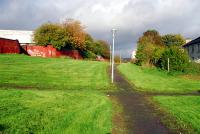
Ruchill Hospital: Ruchill Hospital was served by the only partly built Hamiltonhill Branch which left the CR Dumbarton-Balornock line. The hospital was reached via a headshunt behind the camera.
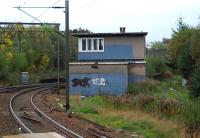
Hyndland: Looking south at the redundant Hyndland Box from Hyndland station. The box is due for demolition as the line here may be quadrupled from Hyndland East Junction to Partickhill.

Hyndland: Glasgow bound train at Hyndland. If the line is quadrupled here the station will be rebuilt with four platforms.

Balado: Looking west at the goods loading bank. To the right of shot the passenger platform is at the edge of the shadow. A ground frame was sited under the camera, released by the single line token, issued between Kinross Junction & Rumbling Bridge.
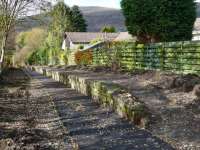
Dollar: Dollar platform. The fence and housing have replaced the station buildings.

Blairingone Siding: This unusual bridge over The Devon Valley Railway is on the unclassified road from Blairingone to Vicar's Bridge and is between Rumbling Bridge and Dollar. The bridge is east of the former Blairingone Siding. The line closed to passenger traffic in 1964.

Balado: Goods loading bank alongside Balado station in October 2007. After WW2 Fleet Air Arm planes were broken up and then transported from here as scrap until 1952.

Lamington: A London Euston - Glasgow Central Virgin Pendolino service at speed on the approach to Lamington on 28 October 2008.

Lamington: Southbound coal hoppers near Roberton (no relation) just south of Lamington on 28 October behind Freightliner 66596.

Crawford Viaduct [Camps Reservoir Railway]: In 1916 Lanark County Council started construction of Camps Reservoir in the hills 3.5 miles east of Crawford. A 3 foot gauge railway was built from Crawford, being completed around 1924, with the reservoir opening in 1930 and the line being lifted ten years later. The photograph shows the viaduct that carried the line over the Clyde, close to the former Crawford Goods Yard (interchange). The well defined trackbed passes between the cottages in the background and heads for the hills.

Crawford Viaduct: A southbound Pendolino approaching Crawford on 28 October 2008. The newly positioned signal alongside the down line has done nothing for what used to be a favourite photo location.
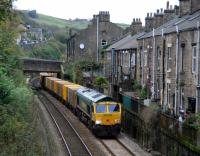
Mossley: 66615 passes through Mossley with 6M05, the 09.30 empty binliner from Roxby to Northenden, in October 2008.

Plates, signs, notices etc: One of the picture panels carried by Class 320s since delivery in 1989. Henry Bell's Comet of 1812 was not the world's first paddle steam vessel but is reckoned to be the first commercial one in Europe. It was built in Port Glasgow and operated on the Clyde. In order to show the paddles the artist has opted to depict the vessel clear of the water, with the part normally below the waterline coloured red. However, together with the background, this does give it the slightly disturbing (or bad trip) appearance of hovering above the water.

Sunnyside Junction: A pair of 320s passing at Sunnyside Junction, just to the west of Coatbridge Sunnyside station, on 28 October 2009. The line south to Whifflet Junction can be seen turning off bottom left here, while in the centre right, hidden behind the trains, is the remains of the junction that latterly served Gunnie Yard and Gartsherrie Cement Works to the north. In the centre left of the picture is part of the Summerlee Industrial museum site.

Coatbridge Sunnyside: On 28 October 2009, unit 320 305 picks up at Sunnyside with a Helensburgh service. For some reason its numbers on this end have been peeled off. Though almost identical to Class 321s, used by several operators in England, 320s are exclusive to the North Clyde Lines; they are unable to use the linked Argyle Line due to clearance restrictions, so while other classes are found north of the Clyde (routinely on the Milngavie branch) the reverse doesn't apply.

Coatbridge Central: I don't visit here very often, but when I do the fine 1899 station building seems to alternate between disuse and use in a new guise. It's back to disuse here on 28 October 2009. The sign boasting a frequent service to Motherwell surely dates from pre-Larkhall branch reopening days when Coatbridge Central was a terminus for electrics as well as the (continuing) hourly Cumbernauld to Motherwell service.

Princes Street [Tram]: View west along Princes Street over the tram works on 28 October 2009. Taken through a window on the top floor of Marks & Spencer.

Princes Street [Tram]: Double tracks along Princes Street. View east towards Waverley through a gap in the chain-link fence on 28 October 2009. See image [[39354]]

Drumgelloch: Looking west towards Drumgelloch station on 28 October. A definite look of something happening.

Coatbridge Central: Northbound 156456 approaches the now fenced off wooden southern end to the platforms at Coatbridge Central with a service for Cumbernauld on 28 October 2009.

Kirkintilloch [2nd]: Kirkintilloch station site has has been redeveloped and no traces remain. However, just beyond the site looking north it is possible to make out the course of the line towards Aberfoyle as seen here on 28 October. Just half a mile to the south lay Kirkie's other station, the folksily (and misleadingly) named Back o'Loch Halt. All traces of that have recently been obliterated in the ongoing construction of a road linking the town with the M80.

Langside: 314 202 approaches the (clearly) island platform at Langside with an Outer Circle working on 28 October 2009.
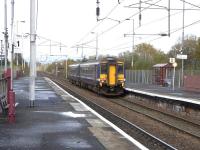
Coatbridge Central: 156 456 pulls out of Coatbridge Central for Motherwell on 28 Oct 2009

Glasgow Queen Street High Level: A view across the buffers at Queen Street on 28 October (Platform 1 is much shorter so deeply reset). Between Platforms 2 and 3 stands the preserved 1842 Edinburgh & Glasgow Railway 1842 milepost - easily dateable as they show the distance to Haymarket (then called Edinburgh) which is one and a quarter miles short of Waverley and was the terminus for only two years. At least 3 of these are still in situ; remarkable to think they have been there since Queen Victoria (God bless her) was only 23 years old and have been wrong since she was 25! See image [[5245]]

Langside: 314 202 pulls into Langside (once known as Langside & Newlands) with an Outer Circle service on 28 October 2009

Bishopbriggs: Looking north east in rapidly fading light at Bishopbriggs on 28 October 2009

Plates, signs, notices etc: Class 320s were delivered in 1989 carrying a selection of what were updated versions of the carriage print, on removable panels, with the themes of Glasgow's buildings and Clyde Coast locations. In this example the railway itself is the subject, with a depiction of Wemyss Bay's most famous building with a class 318, then fairly new, waiting at Platform. (While 318s might have been seen on the line at that time, the much older 303s were the usual fare.)

Stepps: Arrival at Stepps - 170 458 pulls in for Falkirk Grahamston on 28 October 2009
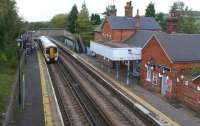
Charing: Looking north west from the road bridge over Charing station in Kent on 28 October 2010. A London bound train operated by Southeastern and formed by unit 375822 pauses at the station.

Barry Pier: The railway used to continue to Barry Pier where trains would meet the paddle steamers from Weston-super-Mare and other ports across the Bristol Channel. The tracks are just visible on the breakwater in October 2010; the island in the background is Steep Holm.

Charing: Looking south east along the up platform at Charing in Kent on 28 October 2010. Note the canopy of the waiting shelter, which appears to have had its awning trimmed. Compare with the same canopy awning on the down platform which has not received the same treatment.

Pluckley: A 12 car Southeastern service made up of three 4 car Class 375 EMUs calls at Pluckley whilst working to London from south Kent on 28 October 2010.
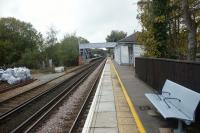
Pluckley: A view west along the long straight section of track at Pluckley, between Ashford and Tonbridge, in October 2010.
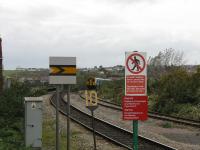
Barry Island: A class 150 inches over the viaduct into Barry Island station. The track on the right belongs to the Barry Steam Railway.

Larkhall: A 334 at the terminus in Larkhall, five years on from re-opening. The first of three major re-openings in Scotland.

Ashford International: A St Pancras bound Eurostar on HS1 just north west of Ashford on 28 October 2010. The tracks on the left are those of the Ashford to Maidstone line.
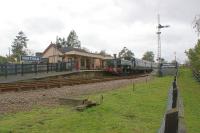
Northiam: Ex GWR Pannier Tank no. 1638 waits at Northiam on the KESR, with a train for Tenterden Town, in October 2010.

Barry Island: A class 143 at the stop sign on the only platform remaining at Barry Island.

Barry Island: At Barry Island station, a bare gantry guards the exit from the island platform.

Barry Island: From the footbridge, the remainder of the platform and the island platform are visible, together with a DMU on the Barry Steam Railway tracks. Note the remaining colour light signals!
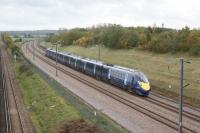
Ashford International: A Southeastern Class 395 six car Javelin set heads towards London on HS1 shortly after leaving Ashford International. The photo was taken from Westwell Lane road bridge in Tutt Hill on 28 October 2010. The Ashford to Maidstone East line can be seen in the bottom left of the photo.
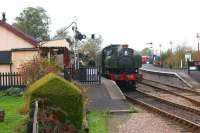
Northiam: Ex-GWR 0-6-0PT no 1638 arrives at Northiam station on the Kent and East Sussex Railway on 28 October 2010 with a train for Tenterden Town.

Ashford International: One of the Hitachi Class 395 high speed electric sets operated by Southeastern is seen on HS1 heading through Kent on a St Pancras to Ramsgate service on 28 October 2010.

Ashford: An MPV on RHTT duties heads south east through rural Kent at Tutt Hill, to the north west of Ashford, on 28 October 2010. The large wall behind the MPV to the right of the line is part of a bridge over the M20 Motorway.

Paisley Gilmour Street: Paisley Gilmour Street on 28 October 2011. The station is clad in scaffolding and hoarding as work progresses on the new roof.
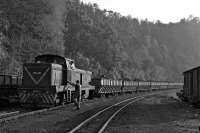
Oskova: Banovici in eastern Bosnia, is on a small coalfield, where a 760mm gauge line connects mines with the standard gauge railhead at Oskova. B-B diesel hydraulic No 740 113 has brought coal into the sidings at Oskova late in the afternoon of 28th October 2011. Forty class 740s were built from 1968 to 1972, but closure of virtually all the Bosnian narrow gauge system meant that their useful life was short, except for a handful which were sold on, including one to the Zillertalbahn see image [[41805]].
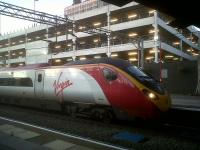
Coventry: The modern image - Pendolino and multi-storey car park at Coventry in 2011.

Torrisholme Junctions: The electrified Morecambe to Lancaster Green Ayre line was a test bed for the Euston 25kv electrification and a variety of different catenary masts and other equipment were used along its short length. Almost all the artefacts were removed after closure but this concrete signal post survives as a lighting pole for the Trimpell Sports Club near to the former North Junction of this triangle of lines. Seen here from the trackbed cycle path, the surviving line to Heysham runs just in front of the houses in the background.
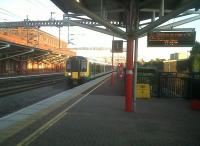
Rugby: When I first visited Rugby station, this platform did not exist. Down slow trains are not as glamorous as fast, so I have neglected photographing it (besides, I am normally changing on the fast lines). The train is a London to Birmingham EMU in October 2011.

Linlithgow: 44871 and 45407 near Linlithgow on 28 October with two support coaches en route from SRPS Bo'ness to their home base at The East Lancashire Railway.

Linlithgow: Black 5s nos 44871 and 45407 on their way home to Lancashire from the SRPS centre at Bo'ness, seen passing Linlithgow on 28 October 2012 with a pair of support coaches in tow.

Curriehill: 44871+45407 run through Curriehill on 28 October 2012 see image [[40842]].
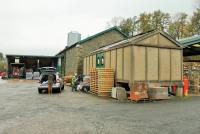
Sedbergh: The old goods shed and the concrete provender store at Sedbergh have been used by Dawsons merchants since they railway yard closed in 1964. The mainline ran to the right of the buildings but a short section of old siding is still in place in front of the large sliding door. Local passenger services ceased in 1954 but school specials and diversions continued into the 1960s. The passenger station survives but under different ownership and is not accessible. Picture taken with kind permission of site owner.

Sedbergh: The old railway weighbridge and associated goods yard offices at Sedbergh, Cumbria, in October 2014. Closure to goods took place in 1964 and since then the yard and goods shed have been occupied by a local fuel and agricultural feeds merchant. [Photograph with kind permission of site owner.] [Ref query 15967]

Easter Road: 67009 passes the overgrown platforms at Easter Road on its return from Powderhall Refuse Depot to Millerhill on 28 October 2014.
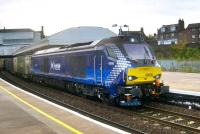
Arbroath: 68006 in Scotrail livery passing north through Arbroath station on 28 October 2016 with the afternoon Grangemouth - Aberdeen Intermodal.
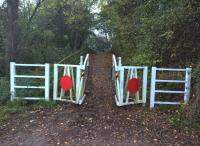
Weddington Junction: As Douglas Adams might have said: almost exactly, but not quite, level crossing gates. Ornamental entrance to the Weddington Railway Walk from Weddington Road.see image [[26581]] for a winter view nearer to the Trent Vally main line.
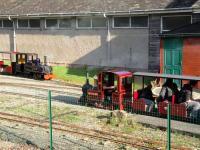
Betws-y-Coed: Passing trains on the 7.25 inch line at the Conwy Valley Railway Museum at Betws-Y-Coed on 28th October 2017. This excellent attraction sits adjacent to the Llandudno to Blaenau Festiniog branch line opposite the station.
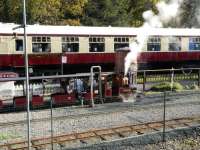
Betws-y-Coed: Train on the 7.25 inch circuit at the Conwy Valley Railway Museum passing one of the standard gauge Mk I coaches used for catering at the site.
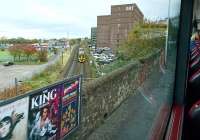
St Margarets Shed: The 1018 Tweedbank - Edinburgh Waverley passing the site of St Margarets shed on 28 October 2017, seen from the top deck of a bus on London Road. At nationalisation the shed had an allocation of over 200 steam locomotives see image [[31096]]. Part of the site is now occupied by St Margarets House, a former government office building, now used as an arts centre providing studio, exhibition and event space.
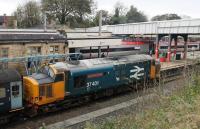
Lancaster: 37401 Mary Queen of Scots idles in Platform 5 at Lancaster on 28th October 2017 before returning to Barrow in Furness with the 1731 hrs (SO) train. A Euston bound Pendolino calls at Platform 4.
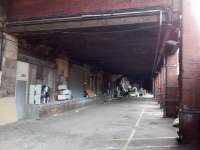
Edinburgh Waverley Goods: The only identifiable bit of the goods station remaining is here, just to the east of the Market Street passenger entrance to Waverley. Newspapers were loaded here from *The Scotsman* building, the basement of which extended under the street. The area is now used as a covered car park, and, from the look of it, dump zone.
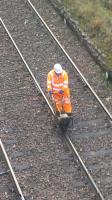
Craiglockhart: Leaves off the line-going the extra mile. This is the site of Craiglockhart Station on the South Sub on 28th October 2018. NR staff using a power brush to clear the rails of leaf mulch. Two or three leaves remain in front of the operator but none behind. This is a very bad area as it is in a deep cutting with many trees above;the tracks are also on a steep gradient making traction control rather challenging. Perhaps this was undertaken in preparation for the SRPS charter train on Nov 3rd. which was to have been steam-hauled?
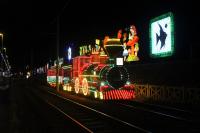
Bispham [Tram]: Visitors to 'The Lights' always pause to watch The Western Train pass by. With one week of the 2018 season to go the popular set (Fleet Nos 733/734) was on Illumination Tours from the Pleasure Beach to Little Bispham on 28th October, seen here heading north past the Bispham tableaus.
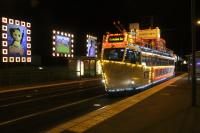
Bispham [Tram]: F736 HMS Blackpool passing the Lowther Avenue stop as it runs south from Bispham with a lights tour during the last week of the 2018 Illuminations. Also in use that Sunday evening were the Western Train tram and four heritage Balloon cars. 28th October 2018.
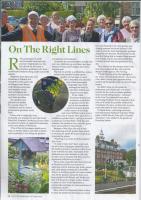
Dumfries: An article about Louis Wall's impressive gardening work at Dumfries station was in autumn issue of The Scottish Gardener distributed with today's Herald on Sunday
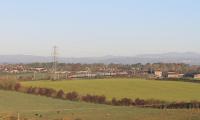
Morecambe South Junction: A bit of autumn sunshine as a nine-car Virgin Pendolino heads north at Morecambe South Junction on 28th October 2019. The signal (PN253) controlling Morecambe branch access can be seen on the left of the picture.
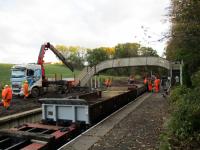
Birkhill: After many months of hard work, both technical and manual, the former West Calder station footbridge was installed at Birkhill on the B&KR on Monday 28th October 2019.
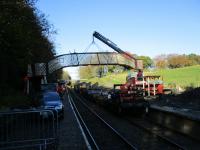
Birkhill: B&KR works train at Birkhill station, during the installation of the former West Calder footbridge on 28th October 2019.
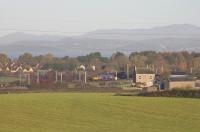
Morecambe South Junction: A Northern Pacer leaves the Morecambe branch on 28th October 2019 to join the WCML for the short run into Lancaster. The branch swings sharply from the junction to run in front of the houses on the left while the WCML catenary masts run to the right. Morecambe Bay, part of Grange-over-Sands and the Lake District mountains can be seen behind.
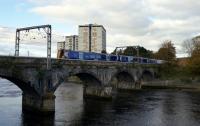
Ayr Viaduct: A Class 380 EMU crosses the Ayr Viaduct on 28th October 2019.
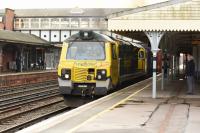
Eastleigh: Perhaps I am getting old but the driver of Freightliner 70015, powering through Eastleigh northbound to Manchester, only looked around twenty five. Good for her! The old days of gradual seniority through the different grades have certainly changed.
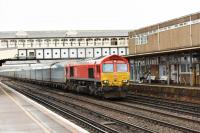
Eastleigh: DB Schencker 66105, heading what must be the longest car train in the UK, through Eastleigh on 28th October 2020.
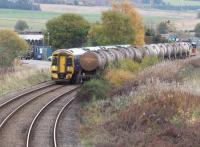
Keith Junction: 158722, on the 1303hrs Keith to Inverness service, passes 70810 on China Clay tanks in the passing loop at Keith on 28th October 2020.
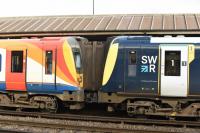
Eastleigh: SouthWest Railways Class 444 EMUs, in different colour schemes, coupled at Eastleigh on 28th October 2020.
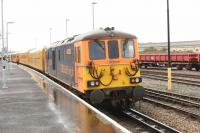
Eastleigh: 73962 leading a local, southbound, Network Rail test train through Eastleigh on 28th October 2020. 73964 was the trailing engine. They reappeared later northbound with 73964 leading.
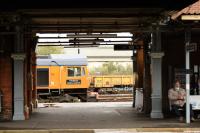
Eastleigh: GBRf 59003 'Yeoman Highlander' moving about Eastleigh station on 28th October 2020.
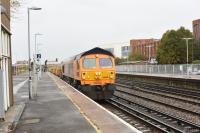
Eastleigh: GBRf 59003, running into Eastleigh with a rake of empty stone wagons, final destination Whatley quarry in Somerset on 28th October 2020.
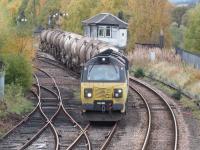
Keith Junction: COLAS 70810 on 6Z42 at Keith on 28th October 2020. The diverted china clay tanks seem to be running twice a week now and I am wondering if the climb out of Inverness towards Perth has something to do with that as there does not seem to be the same number of wagons in tow. Keith signalbox looks as if has seen better days.
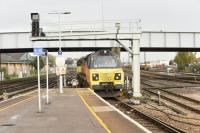
Eastleigh: Colas Rail 70812 shuttling around Eastleigh station on 28th October 2020.
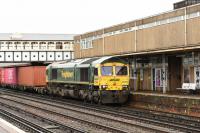
Eastleigh: Freightliner 66592, bound for Southampton, calling at Eastleigh for a driver change on 28th October 2020.
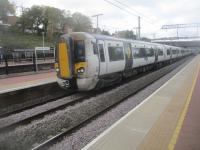
Alexandra Palace: 387126 with 387105 to Kings Cross, speeding south past Alexandra Palace (known as Wood Green until 1982), on 28th October 2021.
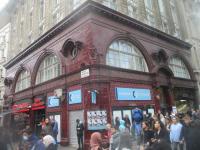
Oxford Circus [CL]: Original exterior of Oxford Circus station, designed by Leslie W. Green (1874-1908) for the Central London Railway, opened on 3rd July 1900 and seen here on 28th October 2021. The station became an interchange with the Bakerloo Line in 1906 and was completely rebuilt below ground and enlarged for the Victoria Line which arrived here on 7th March 1969. (This view is through the lower windows of a TFL bus on route 98 to Willesden Garage that my friends and I travelled on as far as Marble Arch.)
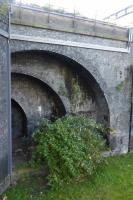
Castlefield Viaduct: This splendid arched brickwork, on a section of the Castlefield Viaduct in Manchester, is unfortunately partly obscured by this unchecked vegetation, especially at ground level. 28th October 2022.

Kirkland Yard: Looking west towards the former Kirkland Yard on 28 October 2022. The Methil branch trackbed is being heavily used by vehicular traffic relating to repairs to the river wall further downstream. Class 107 DCML SC52029 has received some bodywork repairs and paintwork in the Fife Heritage Railway yard to the right.
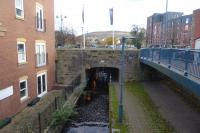
Stalybridge Lock 6 [HC]: The restored Huddersfield Canal in the centre of Staybridge. This view looks east towards the Pennine Hills. Lock 6 is immediately beyond Bridge 100, which is built in traditional style but dates from 2000.
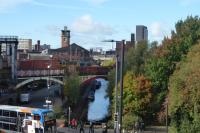
Deansgate: Viewed from the footbridge linking Deansgate railway and tram stations, 66717 is on the last couple of miles of its journey from Felixstowe to Trafford Park on 28th October 2022. Approaching Castlefield Junction the train is also crossing the Rochdale Canal.

Castlefield Junction: 331009 passes under the steel Castlefield Viaduct, now accommodating the National Trust 'sky garden park' and crosses the brick viaduct below with a Manchester Airport to Blackpool North service on 28th October 2022. To the right of the lower bridge are some Roman ruins, together with a reconstruction of a roman wall.
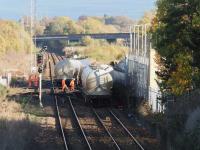
Petteril Bridge Junction: A close up of the pumping operation at Petteril Bridge Junction on 28th October 2022. This is to empty the derailed cement tankers of their loads before they are removed or cut up. The cement is being pumped over the tracks into road tankers that are out of view to the left. This view looks east with the line to Newcastle straight on and the S&C diverging right but then reappearing in view climbing away.
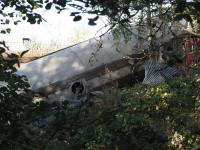
Petteril Bridge Junction: One of the cement tankers, damaged in the Petteril Bridge Junction derailment, having its load pumped out on 28th October 2022. Whether this vehicle will be salvageable or will have to be cut up on site remains to be seen. Access is limited for heavy lifting equipment and the river bridge was also damaged.
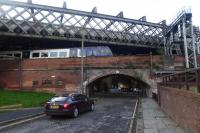
Castlefield Viaduct: 331025 threads the bridges at Castlefield as it approaches the junction of the same name on a Blackpool North to Manchester Airport service on 28th October 2022. The upper bridge, formerly carrying trains out of Manchester Central, is now site of the new National Trust 'sky garden'.
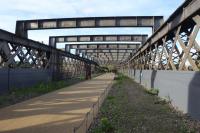
Castlefield Viaduct: After many years of dereliction the Castlefield Viaduct, which once carried trains out of Manchester Central, has been adopted by the National Trust to create a 'green sky park' in 2022. This part of the viaduct opened in 1892 but closed in 1969 and was then unused until this summer, although Metrolink Trams run along a parallel bridge between Deansgate and Cornbrook and there is a brick viaduct passing underneath. Tickets to visit the bridge garden can be booked through the National Trust.
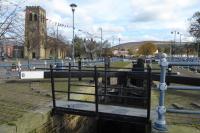
Stalybridge Lock 6 [HC]: Lock 6 of what is now known as the Huddersfeld Narrow Canal is in the centre of Stalybridge and there is a large lock gates artwork alongside. This view looks east in October 2022. The canal has 74 locks and a long tunnel in the comparatively short distance of under 20 miles.
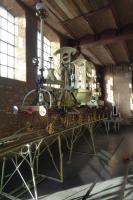
Manchester Liverpool Road: The Manchester Museum of Science and Industry, based around Liverpool Road station and associated warehouses, is undergoing a significant refurbishment during 2022 and 2023 with many halls closed. However, as a fan of Rowland Emmet, this splendid exhibit was good to see. It is a train on the fabled Far Twittering and Oyster Creek Railway and the model moves back and forth on the spindly track.
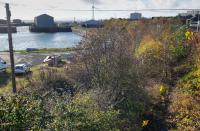
Methil Dock No 1: October 2022 view looking west from the footbridge spanning the former Methil branch, just visible on the bottom right. Dock No.1 is on the left.
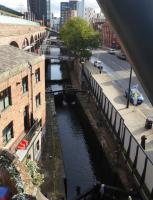
Deansgate: The footbridge that links Deansgate-Castlefield tram stop to Deansgate railway station was originally a perspex tube, which had aged and become opaque. It has now been opened out, and this October 2022 view of the Rochdale Canal is one that wasn't previously visible. A short distance behind the camera is the other Castlefield Junction, where the Rochdale and Bridgwater Canals meet. Below is Dukes Lock No.92, the first of fifty-five between here and Summit.
Events
Events from the chronology which occured on this day. This generally lists events before 1995, the creation of the website.
News
These are old news items which which occured on this day. This generally lists events after 1995, the creation of the website.
| Year | Companies | Description |
|---|---|---|
| 1999 | Awards from the Public Transport Fund | Awards from the Public Transport Fund announcement by the Scottish Transport minister;
- New station for Gartcosh - Possible re-location of Stranraer station - An interchange at Inverkeithing with buses for Edinburgh Airport - Modifications to SPT rolling stock - Improvements to stations in East Renfrewshire and East Lothian |
| 2008 | MAJOR NEW RESEARCH PROGRAMME IN INFRASTRUCTURE ASSET MANAGEMENT [Network Rail Article] | |
| 2009 | Man accused over crossing drama [BBC News] | A 61-year-old man has been accused of ^road traffic offences^ after a bus became trapped under a level crossing barrier. |
| 2010 | Tram tomorrow. Progress of a saga that has engulfed Edinburgh [Scotsman] | IT IS a tale of two tram lines – a hive of activity in some places and a complete lack of progress elsewhere. |
| 2010 | Dream home ruined by new Airdrie - Bathgate railway line [STV] | Resident’s anger after three-and-a-half years living next to a ‘building site’ and erection of new footbridge |
| 2010 | Borders to Edinburgh Railway route bridge demolished [BBC] | A bridge which has fallen into disrepair is being demolished and replaced to help make way for the Borders to Edinburgh railway line |
| 2010 | End of the line for Mull Railway [BBC] | Services on one of Scotland^s most popular narrow gauge railways have been suspended amid fears over its future. |
| 2011 | Put ScotRail under public ownership, urges Labour MSP [Herald] | SCOTRAIL should be brought back into public ownership to bring down the costs of running the rail network and improve services for passengers, Labour’s leadership candidate Ken Macintosh has claimed. The Eastwood MSP attacked rail privatisation, which was set in motion in 1993, as “one of the most ill-conceived, ineffective and impractical decisions of the Conservative administration of the 1980s”, which left passengers facing a “frustratingly complex and expensive rail system”. In an article for the political blog Left Foot Forward, he called for ScotRail, which operates 95% of passenger services in Scotland and will cost £1.5 billion in taxpayer subsidies over the next three years, to be handed to a mutual or not-for-profit organisation “at the next opportunity”. “The decision to create a fragmented series of operating companies was supposedly taken to promote competition, but has produced a frustratingly complex and expensive rail system across the UK completely lacking in transparency and accountability,” he wrote. “Meanwhile, we the taxpaying public pay millions of pounds in subsidies to the shareholders of private companies for the dubious privilege of paying exorbitant prices to travel on a disjointed national network. “At the next opportunity this franchise should be taken back into public ownership to be run by a mutual or other not-for-profit operation. Not only will that improve accountability and our ability to plan public transport strategically, it would save millions for the taxpayer, the commuter, or probably both.” But his comments were attacked as hypocritical and flawed by rival political groups. Jamie Hepburn, the SNP MSP for Cumbernauld and Kilsyth and deputy convener of Holyrood’s infrastructure and capital investment committee, accused both Labour and Conservative governments of “undermining” Scotland’s rail services. “In spite of Westminster cuts that delivered a 36% cut in Scotland’s capital budget, the SNP Government is continuing to invest in railways,” he said. Jackson Carlaw, who is standing for Scottish Conservative leader, branded Mr Macintosh’s proposal’s a “ludicrous” attempt to grab publicity and cosy up to the Labour Party’s left wing. |
| 2011 | Rail line crash farmer ^incredibly stupid^ [BBC News] | A judge has told a farmer who parked a trailer on a rail line which was hit by a train he was ^incredibly stupid^. |
| 2012 | Borders Railway costs up another £50m [Scotsman] | THE cost of the Borders Railway is expected to rise by another £50 million this week when a key contract is signed to begin its long-awaited construction. Sources close to the project said it is now anticipated that the line will cost £350m, despite ministers’ insistence that it must be completed within its £235m-£295m budget at 2012 prices. They also believe the route between Edinburgh and Tweedbank, south of Galashiels, will not be re-opened until late 2015 – a year later than planned |
| 2012 | The rise of rail nostalgia [Telegraph] | In this era of leaves on the line, protests over High Speed 2 and malfunctioning franchises, it is hardly surprising that rail passengers hark back to a golden age. With Michael Portillo, Bradshaw guide in hand, taking to the European rails, railway nostalgia – once the province of spotty boys with notebooks on windy platforms at Clapham Junction – has become all the rage. Indeed, earlier this year the reissued 1863 Bradshaw guide, used by the former Tory rail minister on the domestic excursions that formed his first TV series, became a surprise bestseller. |
| 2013 | Mines blocked to stop Borders Railway collapse [Evening News] | Millions have been spent to block up more than 250 miles of mine shafts to prevent part of the new Borders Railway route from collapsing. At least £10 million has so far gone towards the preventive work, largely at the site of the new Shawfair train station just north of the City Bypass, where contractors have discovered hundreds of shafts left unfilled. The work was revealed as bosses on the project provided an update showing the £350m rail project was on time, and on budget, with the tackling of some of the most challenging aspects well under way. That includes the work to fill in the disused tunnels, which at one time formed part of the Monktonhall Colliery – one of the old Scottish super pits that shut in 1997. |
| 2014 | What is HS3?: proposed sub-Pennine rail line explained [Guardian] | This is the name the government is giving to its ambition to speed up connections between the big cities of the north from east to west. At the moment, the £50bn HS2 network is planned to run from London to Birmingham and then in two forks north, to Leeds and Manchester. HS3 would provide faster direct links across the Pennines between the last two cities, reducing journey times across the north. |
| 2015 | Haymarket station wins engineering award after redevelopment [BBC News] | Haymarket station has won an engineering award following a refurbishment and extension. The 2015 Saltire Civil Engineering Awards is awarded by the Saltire Society and the Institution of Civil Engineers Scotland. It is in recognition of excellence and innovation in civil engineering. |
| 2016 | ScotRail fined over train and station standards [BBC News] | ScotRail has been fined £483,000 for failing to meet required standards for trains and stations. Performance inspectors found areas which missed targets included station toilets, ticket machines, train seats, toilets and cleanliness. The results follow criticism of the ScotRail Alliance franchise, operated by Dutch firm Abellio, for delayed, cancelled and over-crowded trains. |
| 2017 | Rail firm Alstom to close historic Preston site after 120 years [BBC News] | Manufacturer Alstom is to close its Preston site ending 120 years of rail production and maintenance in the city. Preston MP Mark Hendrick raised concerns about 180 jobs leaving the city with news of the closure of the Strand Road factory. Alstom said it will leave Preston by July 2018 and transfer jobs to a new transport centre in Widnes, Cheshire. |
| 2017 | Railway launches £2.5 million fundraising drive [The Press] | A HERITAGE railway that has been running for 50 years has launched a major fundraising drive to keep it going for another half century. Some £2.5 million is needed to secure the future of the North Yorkshire Moors Railway (NYMR). The railway has already been given a £4.6 million Heritage Lottery Fund (HLF) grant, as part of its £9.2 million sustainability project, called the Yorkshires Magnificent Journey Appeal, but the NYMR has to raise around another £2.5 million from members, passengers and the public over the next five years. |
| 2019 | Flood-damaged train line to stay closed for a week [BBC News] | A railway line will remain closed for a week after flooding caused parts of the track to be washed away at the weekend. Network Rail said there was ^significant damage^ between Abergavenny, Monmouthshire and Hereford, Herefordshire. It said engineers were working around the clock at six locations and the line would be closed until 4 November. Rail replacement buses are in operation as 500 tonnes of ballast and 300 tonnes of foundations are replaced. |

